Lahinch Golf Club - The Old Course
Alister MacKenzie (1927)
Lahinch, County Clare, Ireland
Alister MacKenzie (1927)
Lahinch, County Clare, Ireland
I loved Lahinch. With a course architect roster of Old Tom Morris, Alister MacKenzie, and Martin Hawtree, how could any golfer not love Lahinch? Quirky is the best way to describe the layout, but it’s an absolute blast to play. A blind par 3, castle ruins, ocean views, 130 years of history, and pure Irish links all combine to make 18 at the other Old Course something truly special.
A 3:04 pm tee time at Lahinch was my first stop on my Ireland golf trip and first time playing a links course in the British Isles. We touched down in Dublin 30 minutes late after a redeye from Toronto. I worked my way through customs in record time only to endure mild panic during a 90-minute wait for my golf clubs, then almost an hour to rent a Skoda Superba from Sixt Rentals.
Dublin International to Lahinch is 3:01 according to Google and I did it in 2:59 with a stop for food at a combo Circle K / McDonald’s that felt more like Kansas than Ireland. At a dinner the week before, an Irish-born friend casually mentioned the last half hour to Lahinch was a single-lane road and that might have been overstating it. After a crazy ride of playing chicken around every corner in County Clare and holding my breath with every passing car, I pulled into the parking lot and past the famous statue of a goat.
With six hours between scheduled touchdown and tee time, I made it into the golf shop with 20 minutes to spare. I was handed my gift bag and told where to find my caddie. With so little time, I had the choice to roll a few putts or shop the very awesome collection of Lahinch logo gear. I chose to get to know the greens and after a few short putts, I rolled in consecutive 20-footers which is never a good sign. (I’m still regretting a pro shop bender on Lahinch gear.)
Having thoroughly impressed the two middle school kids on the practice green, I wandered over to the first tee and met my caddie and playing partners. My favorite thing about my caddie, and almost all of the caddies in Ireland, is that they belong to the club they work at. As someone who worked at country clubs growing up but was never a member, I viewed the U.S. departure from this egalitarian approach to membership as a grievous mistake and a big strike against golf in North America. To this day, whenever I play a private course, I still don’t feel like I belong there. In my mind, it’s perpetually Monday, when the cart boys, drink cart girls, and the rest of the Danny Noonans of the world get to tee it up.
My playing partners were a gracious father and son from Atlanta, and like my foursome at Ballybunion, were perpetually smiling for the great gift of playing this very special golf course. You can say it’s the history of the land, or the beauty of a seaside links course, or the fact that you’ve traveled to Ireland to play golf, but all of the links courses have a near magical feel to them. It goes beyond Lahinch being a great golf course or that it has an amazing golf architecture lineage. Vibe or mojo or spirit, whatever the course gives off, you can feel it. It’s probably why I didn’t really care about my score or that I smiled when my ball rolled off the green and into a deep pot bunker. It was fun to hit out of a 6-foot-deep bunker and every shot that round had the potential to become a great story.
Before I detail the course, I have to say thanks to Tom Coyne, author of A Course Called Ireland: A Long Walk in Search of a Country, a Pint, and the Next Tee. Without reading this highly entertaining book, I never would have been standing on the first tee at Lahinch. The book also inspired me to rent a car and bring two pairs of golf shoes.
The par-4 “MacKenzie” is a relaxed first hole with a meandering fairway and a green complex designed by the good doctor to get you thinking from the get-go. At 381 from the tips, the hole does have a feel of being designed for persimmon but length is rarely the challenge in Ireland, particularly if the wind is blowing. Two of us played the whites and our third played the green tees as any man in his 70s probably should. I don’t recall what I did off of the first tee. It wasn’t embarrassing like Dooks and it wasn’t in the middle of the fairway like Ballybunion, but I got off the tee and was actually playing golf in Ireland. Ireland! I vaguely remember being short left in two and then chipping it on short only to watch it roll back at me. I carded a six but like I said, I really didn’t care. It was the happiest double of my life.
The par-5 second dubbed “Village” goes back the other way and runs by the clubhouse pub windows and towards the town of Lahinch, thus the name. The dogleg right has twin bunkers on each side so there’s no discriminating against a fade or a draw. Outside of those and you’re in the thick stuff never to be seen again. At 523 from the whites, it’s a three-shot hole for me. I was just off the fairway with my tee shot and then fanned a 5-iron to put me in real Irish rough for the first time. On my third shot, I failed to lay open my 8-iron to get it through the junk and hit the first of many hard pulls from way outside the fairway.
For the 418-yard, par-4 third, the yardage book states, “To put the ball in prime position, the tee shot should be aimed 10 yards to the right of the hill guarding the entrance to the fairway on the left.” Yeah, I can’t do that with a driver. To add to the challenge, the fairway ends 267 yards from the white tees and just disappears for 75 yards before picking up again.
“Cillstifiann” is somewhat forgettable but likely because the fourth hole is the opening act for the greatest pair of consecutive holes in golf, both designed by Old Tom Morris and the only holes left intact from his 1894 redesign. (The original routing was laid out in 1892.)
“Klondyke” is a 472-yard par 5 with a 30-foot hill running across the fairway and behind that, the 17th hole runs between the hill and the 4th green. A windy, somewhat narrow fairway guides tee shots from right to left, setting up a blind second shot over Klondyke Hill. A man stands on the hill holding a red flag, indicating to stand down until he waves the white flag that it’s all clear to swing away. My tee ball kicked off the mound on the right and funneled to the edge of the fairway. I put my approach short right, chipped on and dropped a 15-footer to continue my tradition of birdies on signature golf holes.
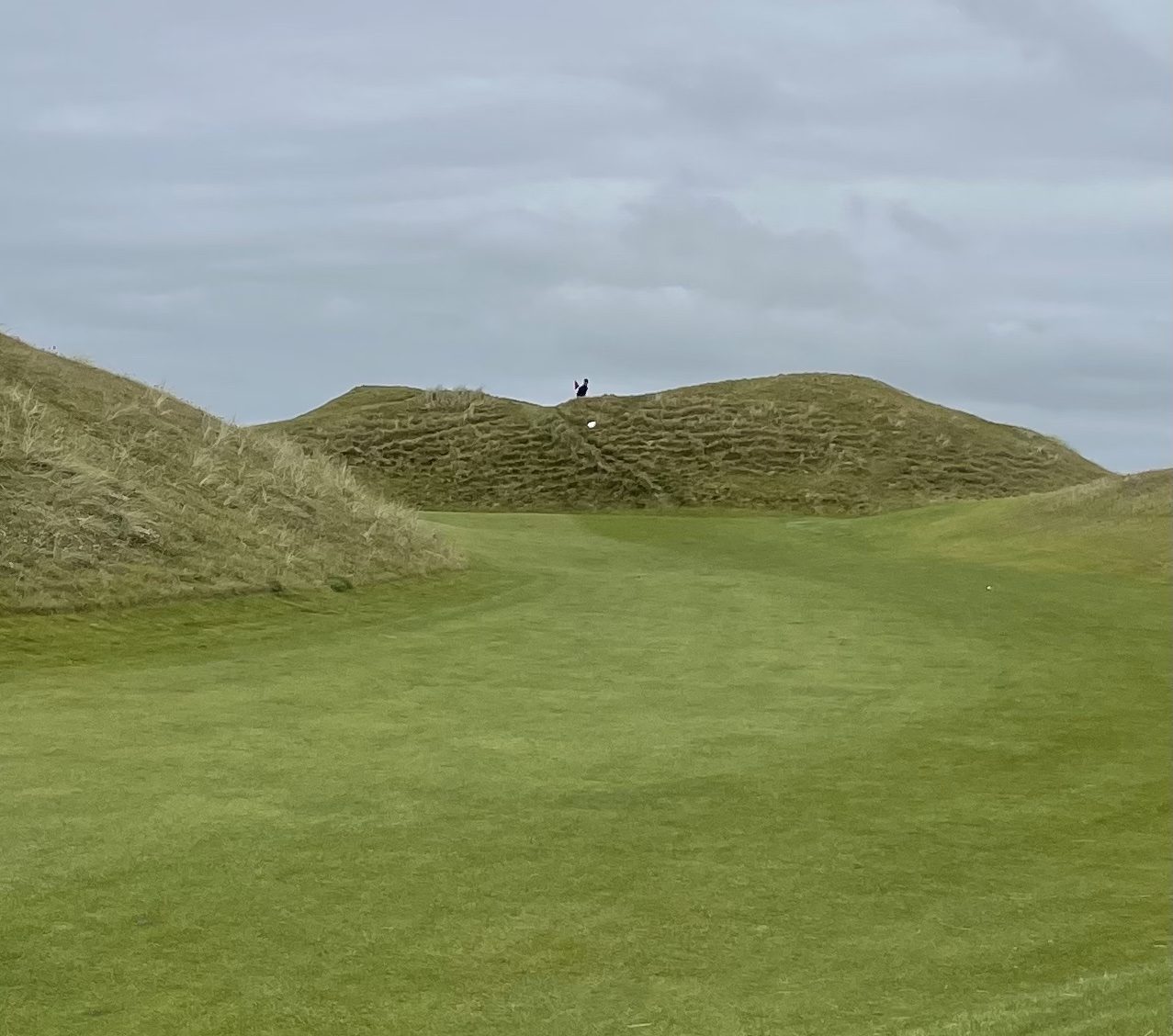
“Dell” is a blind par 3 and the only one I’ve ever heard of. I’m guessing there aren’t too many in the world. The greenskeepers put a white stone on the hill to show you where the line to the flag is and your caddie gives you the distance. Neither mattered for me as I pushed a 9-iron right. Luckily my poor swing landed me in line with the opening of the c-shaped dunes surrounding the green. I carded a disappointing double to play Old Tom’s two holes at +1.
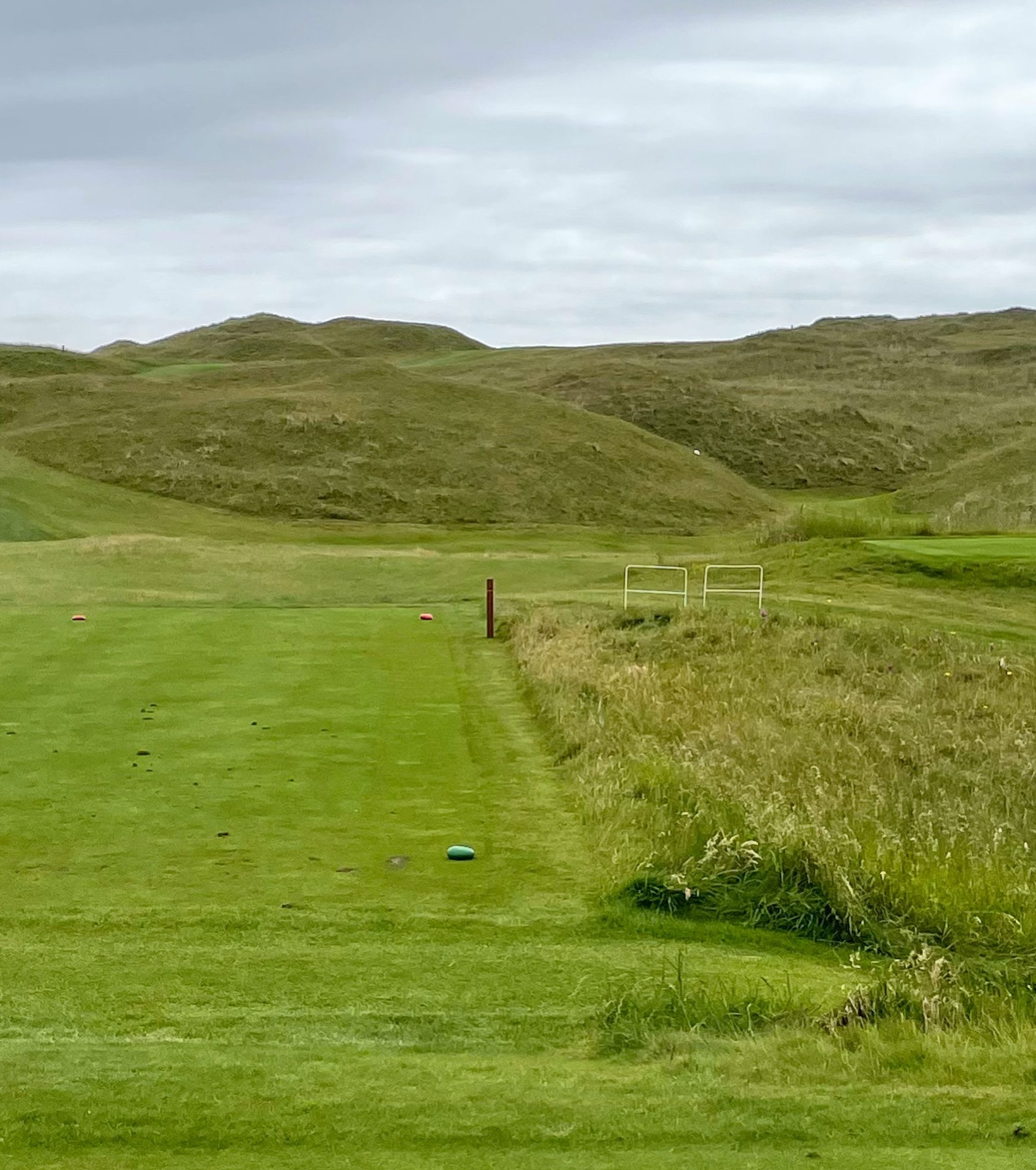
Can you imagine the 4th and 5th with their blind approaches on a course built today? With 125 years of history, they are “quirky” golf holes. As a course designer, you’d need a pair of Pro V1 cajones to drop these holes into a modern routing, but it took strokes of genius by MacKenzie and Hawtree to just leave them alone.
The 6th hole is “Paradise” and once you turn the corner of the dogleg, it’s as pretty as golf holes get. There is a bunker at the end of the landing zone that one of our caddies called “The Devil’s Asshole.” I’ve never been happier with a short drive because 270 would put you in said bunker and it looked like the long-lost twin of the Sarlacc in Return of the Jedi.
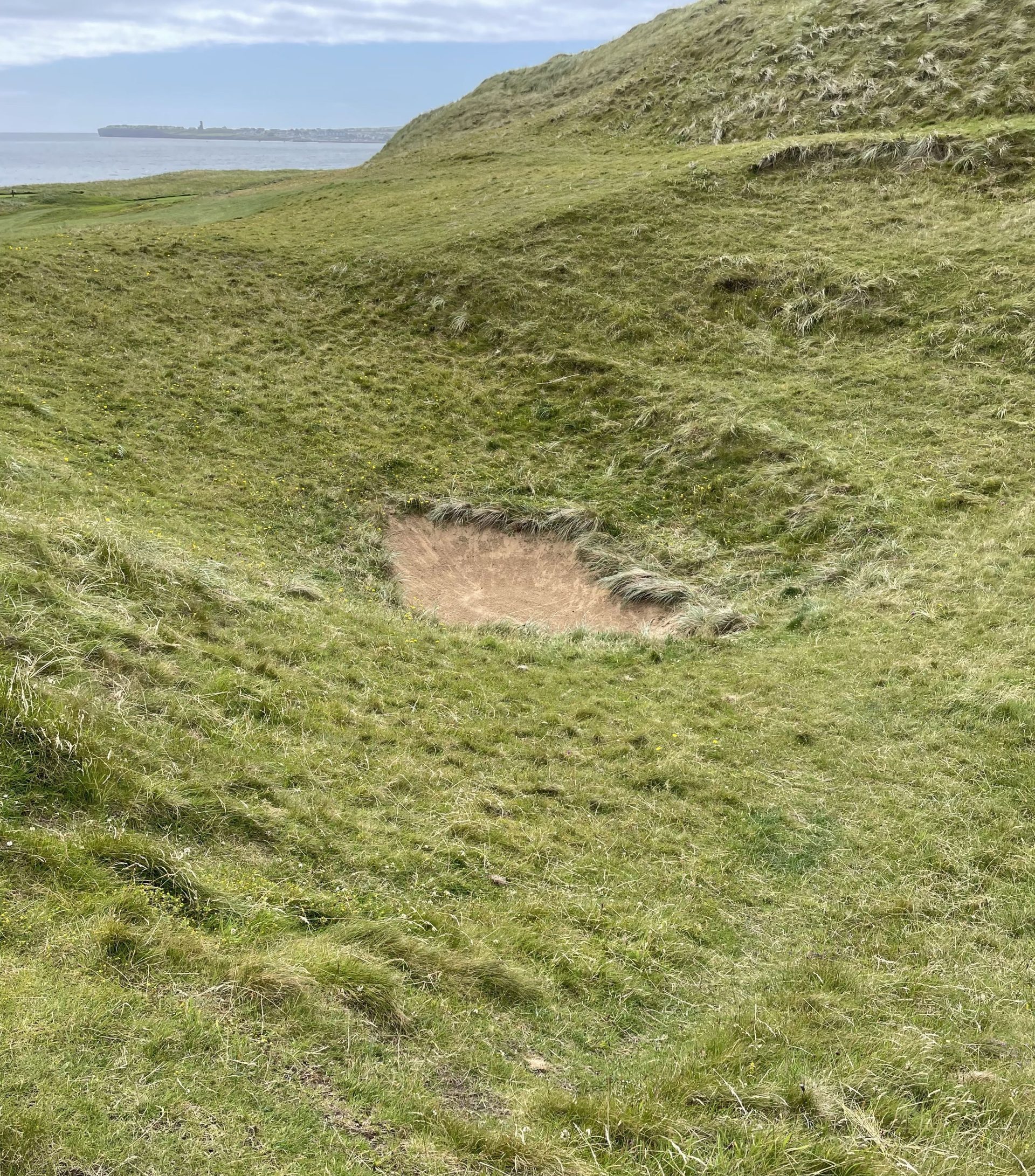
Trust me when I say the pic doesn’t do it justice. This thing was deep and thick. Once you express your gratefulness for not being in Satan’s bunker, you look up and see why the hole gets its name. The green is backed by the beach and a gorgeous view that rivals any ocean course back home.
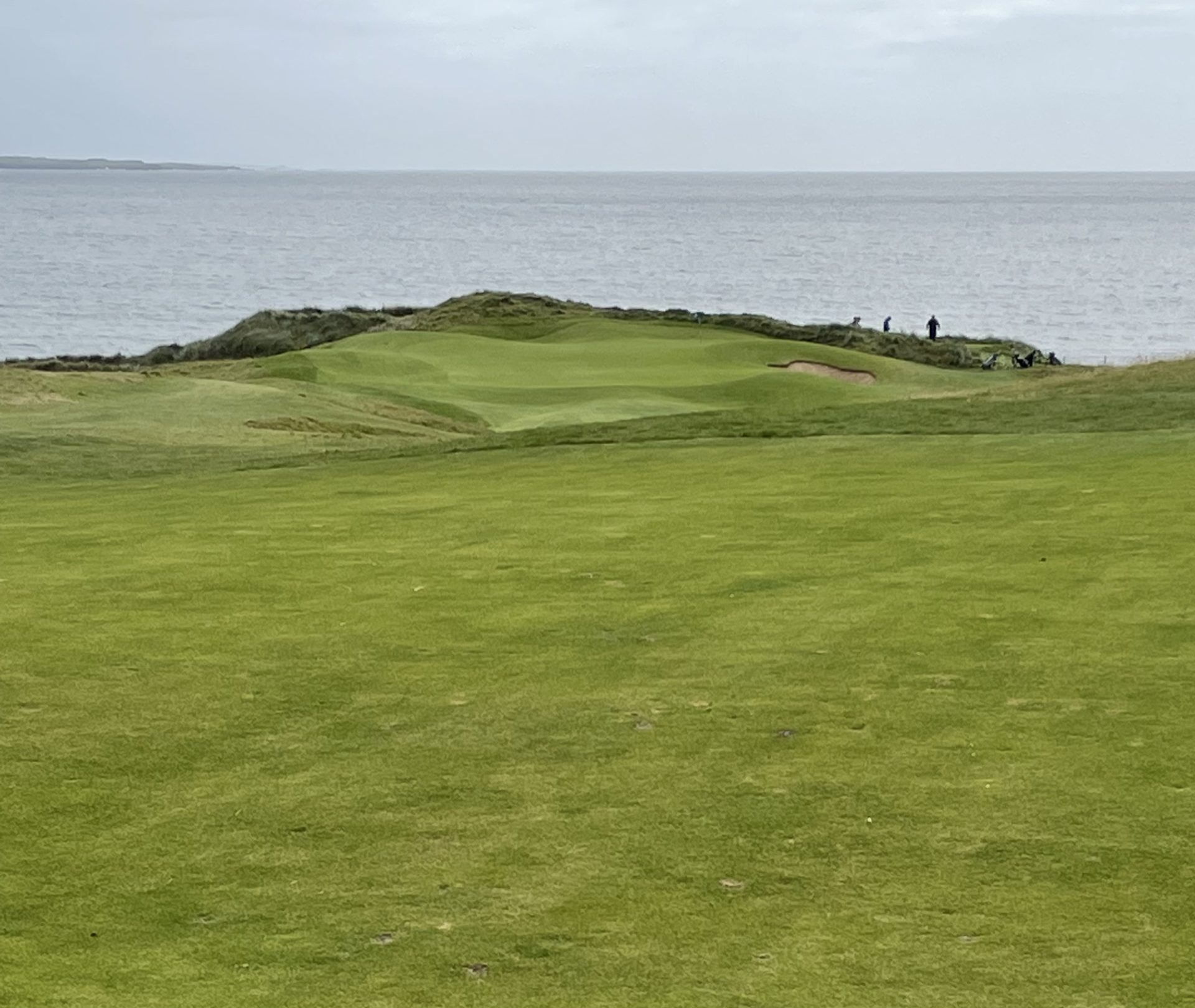
The 7th more or less runs along the beach but doesn’t quite take advantage of it as the dogleg rolls away from the water then comes back to it with a lot of scruffy dunes in between. “Blind Hookey” is also the first hole where the white tees were a big advantage over the blues at 366 vs. 411. Compare that to the previous three holes where a total of 21 yards separated golf mortals from the pros and gluttons.
The uphill par-3 eighth was playing about 160 but the wind kicked up somewhere along the way and was blowing hard across the hole. That, plus bunkers left, right, and center, and this was no walk in the parkland.
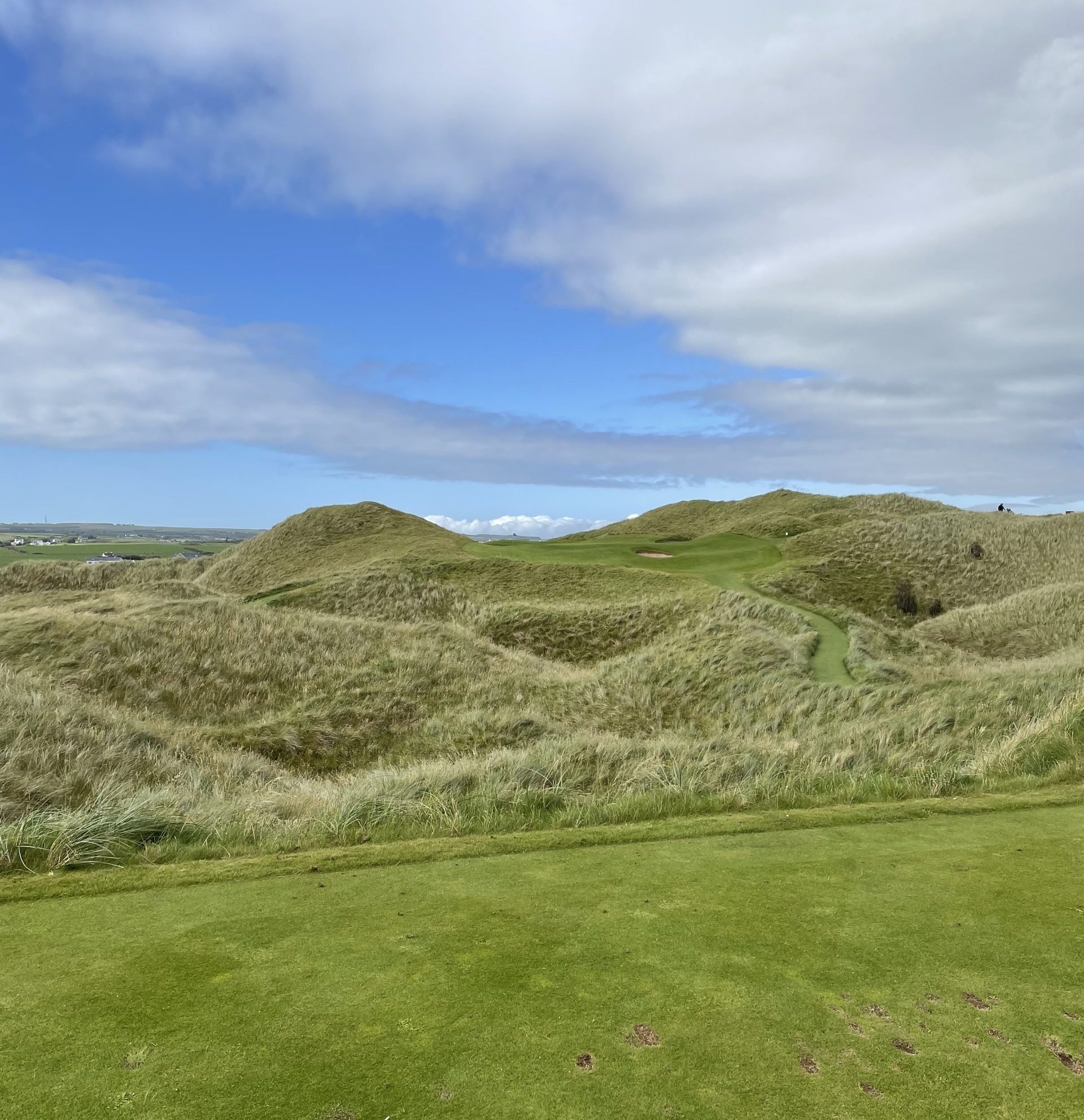
I don’t remember anything about the 380 or so yards that get you to the 9th green. Narrow front to back, sloping seriously right to left with a false front and a bunker on the right. Our threesome put one in the bunker, one from fairway to green and back to fairway, and the third ball is still MIA. If anyone finds a Titleist AVX 3 buried in the deep rough on the dune 50 feet right of the green, please return it to this writer.
The fairway and green on “Goats”, the par-4 tenth, played like Maxwell rolls. The approach to the green felt like you weren’t invited to the party with a raised front edge, four bunkers, and steep dunes left, right, and deep. It’s the No. 3 handicap hole because the fairway is about as wide as an Irish country road and with just as many bumps.
“Well protected” is a phrase that occurs a lot in the Lahinch Yardage Guide but the par-3 eleventh deserves a stronger warning. Bumping up against the beach and surrounded by steep dunes, anything not on the green or in the unplayable rough, is funneled into one of the three bunkers. Add in an indecipherable diagonal wind and I spent extra quality time with my caddie searching a square meter of rough on top of the large dune on the left. It’s a great par 3 with an even better ocean view, but the most interesting thing about “Liscannor” was the alternate green for hole 11A, designed by Alister MacKenzie for when the main green is getting too much play.
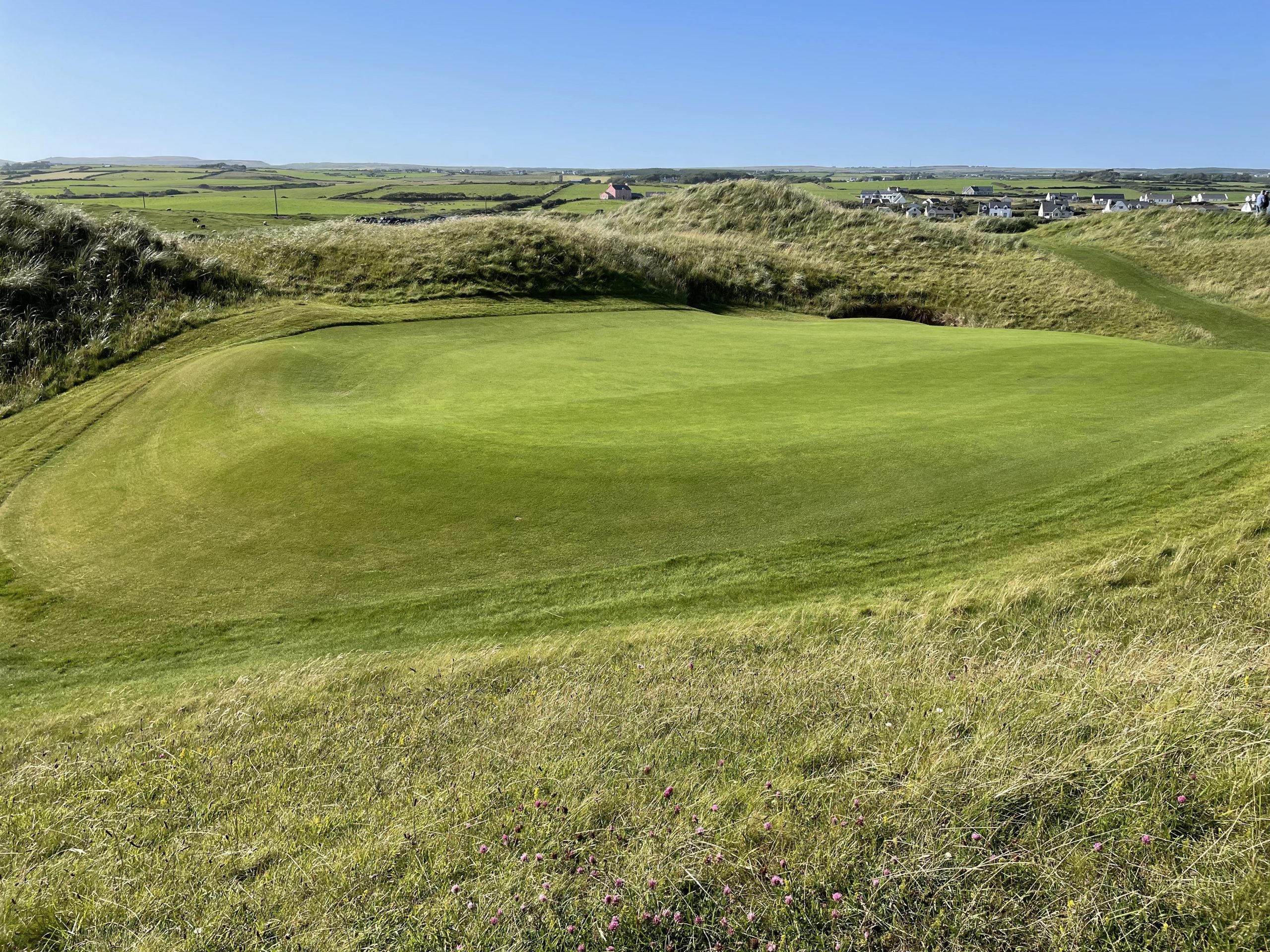
Can you imagine the guy who designed Augusta built your backup green? That’s like Randy Johnson in your bullpen. By the way, while only 134 yards, 11A looked like nothing but bad pin placements and a 3-putt waiting to happen. MacKenzie’s green was Pasatiempo meets Pinehurst with a backstop back right and steep soft edge all along the left.
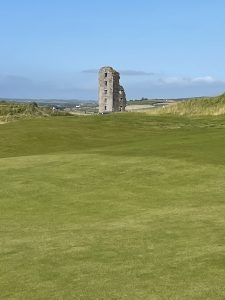
For the 12th, the line is 10 yards right of the castle. How often do you hear that in the states? The cool thing is there’s another castle across the water. The ruins are towers that used to communicate with torches to keep everyone in the know. The par 5 wraps around the surf beach and while you’re gawking at history and mother nature, your ball likely rolled into one of the four bunkers guarding the green.
A chunked wedge that doesn’t leave your shadow and a long iron second shot into a driveable par 4 are my two least favorite outcomes in golf. Introducing “Mine”, the par-4 thirteenth with 267 yards from tee to a small tiered green. I found the deep rough by the 16th tee and disgrace followed me from there.
“Twins” is named for the pair of C-cups that pinch the fairway down to a cart path on the long par-4 fourteenth. I have no idea how this is the No. 5 handicap hole at 451 yards, a bunker at 260 out, an Olympic mogul run down each side, a prevailing crosswind, and bunkers left and right because why not. I did not like this hole because I had no idea how to play it. It was possibly the only time a smile left my face all day, although not for long.
The par-4 fifteenth is 14 without the Twins. A long, straight par 4 stretching to 439 with a bumpy ride on either side of the fairway and plenty of trouble to be found wherever you go.
The 16th is fairly non-descript compared to the other par 3s. It’s 190+ but the wind should be at your back. “Old Tom” heads toward the road and you’re either on the dance floor or in one of the four welcoming bunkers, or you’re in bigger trouble.
The 17th reminded me of the string of holes at Whistling Straits where anything right and you’re f-ed for the entire length of the golf hole. Bunkers, rough, dunes, deeper rough. I think I lost two balls here as either you see your ball or it’s never to be seen again.
The par-5 finisher was a departure for nearly every U.S. course with a far-too-long par 4 on 18 when you always need a par to break 80, 90, or 100. I count 15 of 18 holes that were fantastic and three more that were good but maybe not great. My playing partners felt the same way as we all had more smiles than strokes and we counted a lot of strokes at Lahinch.
Wow, Lahinch is one hellaciously fine golf course. Considering it’s called the St. Andrews of Ireland, I’m not alone in my opinion. It was my new favorite course for two days until I played Ballybunion. I’ve never experienced a golf course like it anywhere in North America. Quirky? Yes, but so much fun.
The experts rank Lahinch 36th on Golf Magazine’s Top 100 Courses in the World, 41st on Golf Digest’s World’s 100 Greatest Golf Courses (down from 31st the previous year), 11th on Golf Magazine’s Top 100 Courses in UK & Ireland, and 11th on Top 100 Golf Courses for Britain & Ireland. I was really disappointed not to play Royal County Down while I was in Ireland as that would have been the measuring stick, but I’ll have to take a lot of other people’s word for it. Ireland & Northern Ireland’s Top 5 looks something like: 1. Royal County Down, 2. Ballybunion, 3. Lahinch, 4. Royal Portrush, 5. Portmarnock.

– Chris Austin — Founder, Editor, Writer, Traveling Golfer